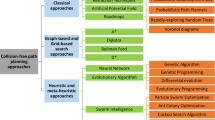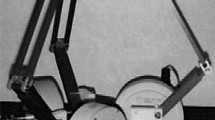Abstract
This work describes a novel robot manipulator with configurable platform. Three internal degrees-of-freedom are added for controlling the relative orientation of the terminal links supporting multiple end-effectors of a Gough–Stewart-type parallel manipulator. The instantaneous forward and inverse kinematic analyses of the robot are derived using the theory of screws. Furthermore, the exploitation of this approach for deriving the acceleration analyses of a parallel manipulator with configurable platform is novel in this research field. As an intermediate step the forward and inverse displacement analyses are also investigated. A numerical example is compared with the outcome of a commercial software demonstrating the approach correctness.









Similar content being viewed by others
References
Bates DJ, Hauenstein JD, Sommese AJ, WamplerII CW (2005) Numerically solving polynomial systems with bertini (software, environments and tools). Society for Industrial and Applied Mathematics, New Delhi
Cavacanti-Santos J, da Silva MM (2017) Redundancy resolution of kinematically redundant parallel manipulators via differential dynamic programing. J Mech Robot 9(4):041016
Craig JJ (1986) Introduction to robotics: mechanics and control. Addison-Wesley Publishing Company, Massachusetts
Ding W, Yao Y (2015) Self-crossing motion analysis of a novel in pipe parallel robot with two foldable platforms. In: Corves B, Lovasz EC, Husing M (eds) Mechanisms, transmissions and applications Mechanism and machine science. Springer, Dordrecht, pp 221–229
Gallardo J, Alcaraz LA (2018) Kinematics of the Gough–Stewart platform by means of the Newton-homotopy method. IEEE Lat Am Trans 16(12):2850–2856
Gallardo-Alvarado J (2014) A simple method to solve the forward displacement analysis of the general six-legged parallel manipulator. Robot CIM Int Manuf 30(1):55–61
Gallardo-Alvarado J (2016) Kinematic analysis of parallel manipulators by algebraic screw theory. Springer, New York,
Gallardo-Alvarado J, Rico-Martinez JM (1998) Screw theory and helicoidal fields. In: Proceedings of the ASME 1998 design engineering technical conferences, paper DETC98/MECH-5893
Gallardo-Alvarado J, Rico-Martinez JM (2001) Jerk influence coefficients, via screw theory, of closed chains. Meccanica 36(2):213–228
Gallardo-Alvarado J, Tinajero-Campos JH (2019) A parallel manipulator with planar configurable platform and three end-effectors. Math Prob Eng 2019:7972837
Gosselin C, Schreiber LT (2018) Redundancy in parallel mechanisms: a review. Appl Mech Rev 70(1):010802
Haouas W, Dahmouche R, Fort-Piat NL, Laurent GJ (2018) A new seven degrees-of-freedom parallel robot with a foldable platform. J Mech Rob 10(4):045001
Hoevenaars AG, Lambert P, Herder JL (2014) Kinematic design of two elementary 3-dof parallel manipulators with configurable platforms. In: Thomas F, Pérez-Gracia A (eds) Computational kinematics. Mechanisms and Machine Science, Springer, Dordrecht, pp 315–322
Hoevenaars AGL, Gosselin C, Lambert P, Herder JL (2017) A systematic approach for the Jacobian analysis of parallel manipulators with two end-effectors. Mech Mach Theory 109(1):171–194
Isaksson M, Gosselin C, Marlow K (2016) An introduction to utilising the redundancy of a kinematically redundant parallel manipulator to operate a gripper. Mech Mach Theory 101:50–59
Lambert P, Herder JL (2014) Self dual topology of parallel mechanisms with configurable platforms. In: Thomas F, Perez-Gracia A (eds) Computational kinematics. Mechanism and machine science, vol 15. Springer, Dordrecht, The Netherlands, pp 291–298
Lambert P, Herder JL (2016) Parallel robots with configurable platforms: fundamental aspects of a new class of robotic architectures. Proc Inst Mech Eng Pt C J Mech Eng Sci 230(1):11–47
Luces M, Mills JK, Benhabib B (2017) A review of redundant parallel kinematic mechanisms. J Intell Robot Syst 86(2):175–198
Maciejewski AA, Klein CA (1985) Obstacle avoidance for kinematically redundant manipulators in dynamically varying environments. Int J Robot Res 4(3):109–117
Merlet JP (2004) Solving the forward kinematics of a Gough-type parallel manipulator with interval analysis. Int J Robot Res 23(3):221–235
Mohamed MG (2003) Kinematic analysis of redundant parallel manipulators. In: Proceedings IEEE 7th international conference on intelligent engineering systems
Mohamed MG, Gosselin C (2005) Design and analysis of kinematically redundant parallel manipulators with configurable platforms. IEEE Trans Robot 21(3):277–287
Mueller A (2008) Redundant actuation of parallel manipulators. In: Wu H (ed) Parallel manipulators. IntechOpen, Rijeka
Mueller A (2011) Problems in the control of redundantly actuated parallel manipulators caused by geometric imperfections. Meccanica 46(1):41–49
Orekhov AL, Simaan N (2019) Directional stiffness modulation of parallel robots with kinematic redundancy and variable stiffness joints. J Mech Robot 11(5):051003
Pierrot F, Nabat V, Company O, Krut S, Poignet P (2009) Optimal design of a 4-dof parallel manipulator: from academia to industry. IEEE Trans Robot 25(2):213–224
Raghavan M (1993) The Stewart platform of general geometry has 40 configurations. J Mech Des 115(2):277–282
Sommese AJ II, CWW, (2013) The numerical solution of systems of polynomials arising in engineering and science. World Scientific, Singapore
vanKnippenberg R, Habraken A, Teuffel P (2016) Deployable structures using non-singular rigid foldable patterns. Procedia Eng 155(1):388–397
Verschelde J (1999) Algorithm 795: PHCpack: a general-purpose solver for polynomial systems by homotopy continuation. ACM Trans Math Soft 25(2):251–276
Wampler CW (1996) Forward displacement analysis of general six-in-parallel SPS (Stewart) platform manipulators using Soma coordinates. Mech Mach Theory 31(3):331–337
Wang J, Gosselin C (2002) Singularity analysis and design of kinematically redundant parallel mechanisms. In: Proceedings ASME Design Engineering Technical Conferences, pp 953–960
Wang Y, Belzile B, Angeles J, Li Q (2019) The modeling of redundantly actuated mechanical systems. J Mech Robot 11(6):061005
Wu J, Wang J, Wang L, Li T (2009) Dynamics and control of a planar 3-DOF parallel manipulator with actuation redundancy. Mech Mach Theory 44(4):835–849
Wu J, Gao Y, Zhang B, Wang L (2017) Workspace and dynamic performance evaluation of the parallel manipulators in a spray-painting equipment. Robot CIM Int Manuf 44(4):199–207
Wu J, Yu G, Gao Y, Wang L (2018) Mechatronics modeling and vibration analysis of a 2-DOF parallel manipulator in a 5-DOF hybrid machine tool. Mech Mach Theory 121(3):430–445
Wu TM (2005) A study of convergence on the Newton-homotopy continuation method. Appl Math Comput 168(2):1169–1174
Wu TM (2006) The inverse kinematics problem of spatial 4p3r robot manipulator by the homotopy continuation method with an adjustable auxiliary homotopy function. Nonlinear Anal 64(10):2373–2380
Yi BJ, Na HY, Lee JH, Hong YS, Oh SR, Suh IH, Kim WK (2002) Design of a parallel-type gripper mechanism. Int J Robot Res 21(7):661–676
Acknowledgements
The author gratefully acknowledges with thanks the support of two Mexican Institutions: the National Council of Science and Technology (CONACYT) through the National Network of Researchers (SNI) fellowship (Grant Number 7903) and the Tecnológico Nacional de México (TecNM). On the other hand, thanks go to Jesus H. Tinajero-Campos for developing the solid model of the robot manipulator.
Author information
Authors and Affiliations
Corresponding author
Ethics declarations
Conflict of interest
The author declares that he has no conflict of interest.
Additional information
Publisher's Note
Springer Nature remains neutral with regard to jurisdictional claims in published maps and institutional affiliations.
Rights and permissions
About this article
Cite this article
Gallardo-Alvarado, J. A Gough–Stewart parallel manipulator with configurable platform and multiple end-effectors. Meccanica 55, 597–613 (2020). https://doi.org/10.1007/s11012-020-01136-y
Received:
Accepted:
Published:
Issue Date:
DOI: https://doi.org/10.1007/s11012-020-01136-y




